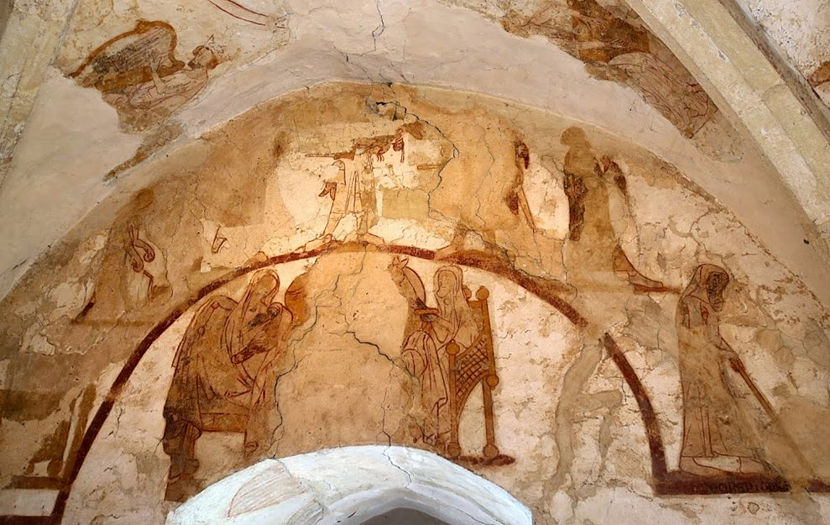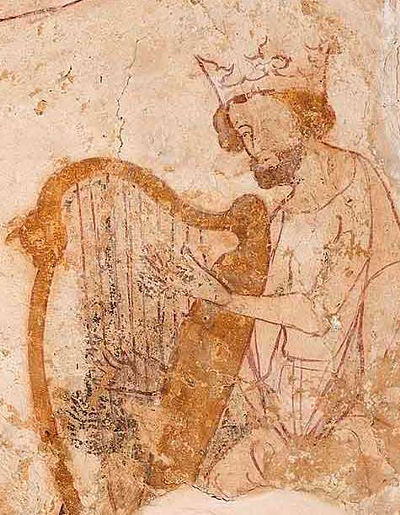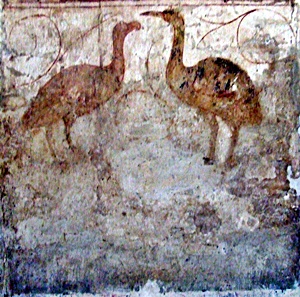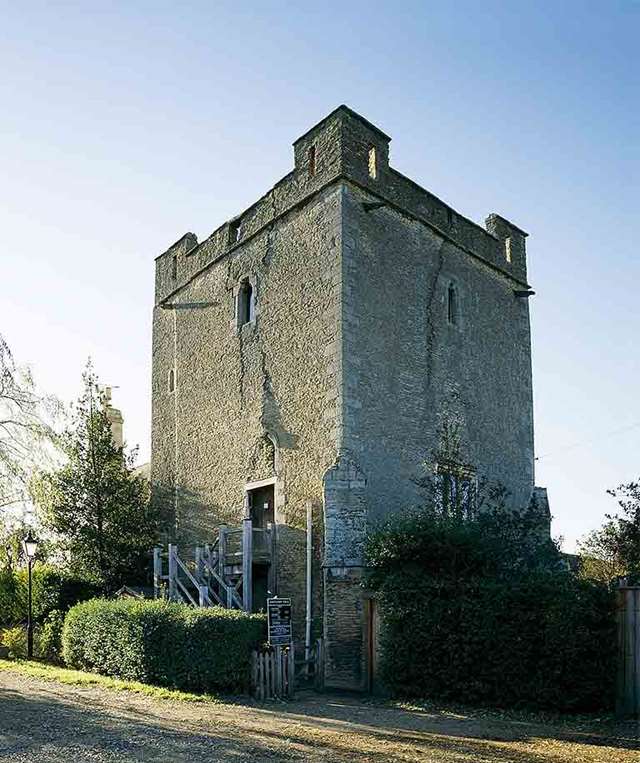Longthorpe Tower, Peterborough, Cambridgeshire c.1310
The Great Chamber at Longthorpe represents a new departure for this site. It is not a church, but part of a domestic building containing a room with all four walls fully painted with various scenes and subjects, sacred and secular. Its very existence demonstrates the often blurred dividing line between sacred and secular preoccupations in this period. The tower, which is open to the public only occasionally is now entered by an external stone staircase which brings you into the the Great Chamber.
North Wall

This is the wall on the right as you enter the Chamber. The most important painting here is the Nativity, which is the scene in the arched space above the dark arch below. At the left is the Virgin Mary holding the tightly swaddled infant Christ The ox and the ass were also once here in the centre of the group, but all I can make out now is something that may be the ears of the ass as it looks down towards an area of vanished plaster which probably once showed the manger. Beyond this sits Joseph in a chair of quite elaborate design, perhaps intended for wickerwork.
Above this Nativity group, in an illusionistic painted arch, are scenes representing the Seven Ages of Man, with, starting at the left beyond Mary, an infant in a sizeable cradle, further round the arch a boy with a whip and ball, the lower part of a young man with confidently-placed legs at the top of the arch, a man with a hawk as the arch descends, and finally a man with a hooded robe and a walking stick or sticks, representing Decrepitude.

Below in this photograph are the upper halves of a series of paired Apostles, which forms a tier running around some of the walls of the chamber. I will return to this group of Apostles at a future update, but what matters for now in this initial look at Longthorpe is the vertical arrangement of scenes, with the central event of the Nativity given pride of place, and the progression of human life from infancy to old age arching around it.
Crowning these at the top of the wall in the roof vault is an Old Testament scene of David playing the harp, with another near-indecipherable scene in the corresponding vaulted space opposite it. As far as I can see from sketches by E Clive Rouse in his booklet on Longthorpe Tower, this appears to be a member of the angelic host (or possibly another Old Testament personage) playing another instrument, perhaps a zither, or, more likely, the ancient psaltery mentioned in 1 Samuel:20-5 and in many psalms. In the centre between these musicians I think I can see the edge of a mandorla, which I suspect would once have contained a figure of God, enthroned amid the music of the spheres. This would make sense in a world of medieval symbolism, and a black-and-white drawing by Clive Rouse in the English Heritage booklet seems to bear it out, but it is impossible to say more now.

So, on this north wall of the Great Chamber at Longthorpe, it is possible even from one wall to make out something of the painter’s schematic intentions. At the very top of the vaulted ceiling is the heavenly realm where abstractions such as music hold sway. Below this, represented symbolically by the Seven Ages of Man, comes the quotidian, created world dominated by Man.
In the lowest tier, below the Apostle ‘supporters’, the lowest element of Creation, the natural world, is illustrated. Birds and beasts (some of them very strange indeed) are represented at this level, and here on the left-hand side of the north wall, to the left of the alcove are two large birds, one of which might just be a Great Bustard, once common in East Anglia, but now exceptionally rare. These are pictured near the bottom of this page. The Apostles and the Nativity, representing as they do the possibility of eventual human access to God’s realm come below this, and then comes the natural world, over which Man, even in his flawed postlapsarian condition, still retains lordship.
Longthorpe is administered by English Heritage. Photography is permitted, and be careful on that external staircase.
